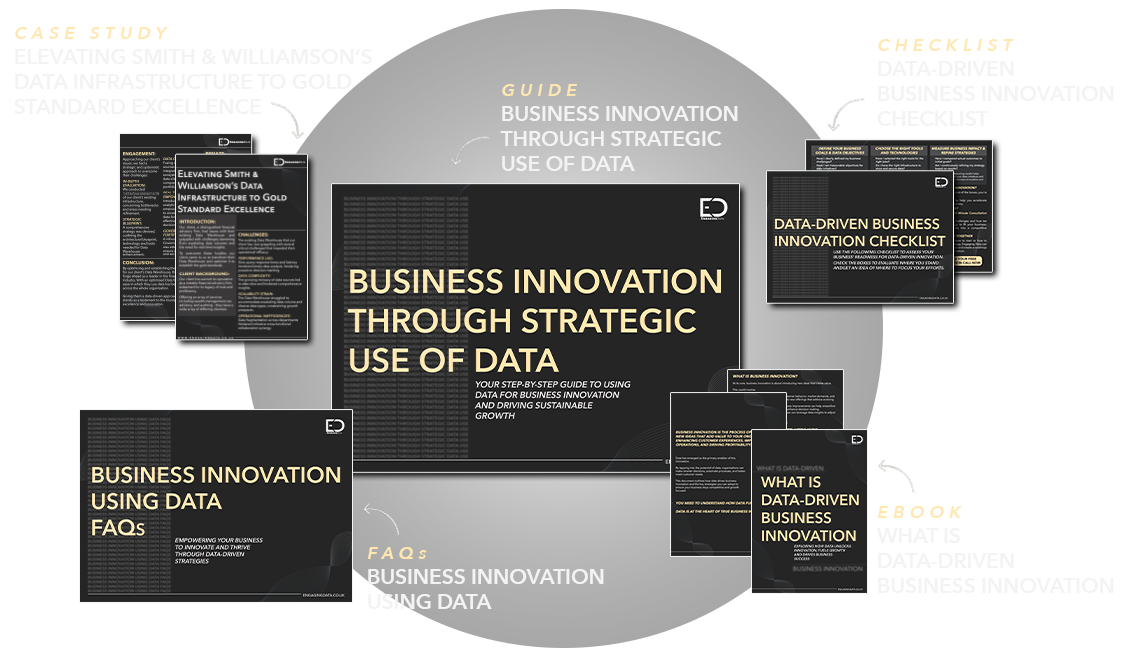10 Proven Tips for Optimising Business Innovation with Data
Data is essential for innovation.
For business, especially in Financial Services and Manufacturing, making the most of your data. Using data, you can thrive in a world where opportunities (and challenges) move faster than ever!
Here are 10 practical tips to help you unlock the true potential of your data and drive real business impact and innovation.
Define Clear Objectives for Data-Driven Innovation
Without clear goals, even the best data strategy can veer off course.
Start by asking yourself: “What do we want to achieve with our data?”
Is it faster delivery times? Better customer insights? Lower production costs?
Pinpointing your goals keeps your innovation efforts focused and measurable.
For example, a manufacturing company might aim to reduce downtime by 15% through better equipment monitoring. Or a financial services firm could use data to improve client onboarding times.
Whatever your focus, clarity is key.
Tip: Don’t try to tackle everything at once! Pick an objective to start with and build from there.
Need help setting your data objectives?
Download our free Data Innovation Toolkit to put you on the road to true business innovation.

Build a Scalable Data Infrastructure
Outdated systems create frustrations for businesses trying to harness the power of data and innovation effectively.
Investing in scalable infrastructures, think cloud platforms and real-time analytics, ensures your data can grow and adapt alongside your business.
Tip: Prioritise tools that can integrate seamlessly with your existing systems and offer plenty of room for growth. It will inevitably happen.
Leverage Predictive Analytics for Decision-Making
Predictive analytics helps you anticipate what is coming next.
Whether predicting maintenance needs in a factory or spotting shifts in consumer behaviour, these insights can save more time, money, and frustration.
Tip: If predictive analytics feels overwhelming, start with one use case. The results will speak for themselves. Easily getting buy-in from leadership and stakeholders.
Foster a Data-Driven Culture
Even the best data tools won’t deliver results if your team isn’t on board.
Building a data-driven culture requires more than just software; it requires buy-in from everyone – from leadership to front-line staff.
Show your team how data can make their jobs easier and their results better.
Tip: Celebrate early wins. Demonstrating quick success builds momentum and gets the skeptics on your side!
Ensure Data Governance and Compliance
Compliance might not be the most glamorous or exciting part of data innovation – sorry!
But it is absolutely vital.
Mishandling data or falling foul to GDPR regulations can lead to fines or a loss of trust. So, you need to get it right and get it right the first time!
Robust governance practices, like regular audits and secure data storage, protect your business and give you a competitive advantage.
If you’re working across multiple countries, navigating regulations is critical. A clear governance strategy keeps everything above board and stress-free.
Tip: Don’t leave governance to chance. Assign clear data ownership and responsibilities within your team.
Do you want more insight into how to improve your Data Governance?
Our Data Innovation Toolkit provides more insight!
Get the Download Now.

Combine AI and Machine Learning for Smarter Insights
AI and machine learning (ML) have moved from buzzwords to game-changers.
Whether it’s automating repetitive tasks, optimising production lines, or predicting fraud, these technologies can elevate your data strategy to new heights.
Tip: Before implementing AI or ML practices, your data must be clean, clear, and governed correctly. Otherwise, if there’s shit going in, guess what will come out…
Collaborate Across Teams and Departments
Silos don’t just limit communication. They limit innovation.
Bringing IT, operations and business teams together ensures that your business innovation initiatives serve the whole business, not just one department.
For example, in manufacturing, IT might provide tools for real-time monitoring, but operations teams know what metrics matter most on the factory floor.
Collaboration ensures those insights are useful.
Tip: Set up regular cross-departmental check-ins to align goals and share results. Don’t use guesswork!
Focus on Sustainability with Data
Sustainability isn’t about being green; it is also about creating long-term value.
Data can help you identify areas where you can reduce waste, optimise energy use, or improve supply chain efficiency – all while boosting your bottom line!
Tip: Look for sustainability wins that also offer clear financial benefits, it’s easier to justify the investment that way!
Track ROI of Data Initiatives
Data projects often struggle because their value isn’t clear.
By tracking ROI, you can demonstrate exactly how these initiatives contribute to your business goals.
Focus on metrics like cost savings, revenue growth, or improved efficiency. Something that your boss would LOVE to hear about!
Tip: Share ROI successes with your team to keep everyone motivated and invested. (It also lets you brag about your success!)
Partner with Experts to Accelerate Results
That’s right, we had to sneak this one in!
But sometimes, it’s not about working harder, it’s about working smarter.
Partnering with a team that knows the ins and outs of data-driven business innovation can save you time, reduce risk, and maximise results.
At Engaging Data, we’ve helped businesses similar to yours optimise their operations, achieve measurable growth, and unlock new innovative ideas by using data.
Data is your secret weapon for innovation, but it needs direction and focus.
By applying these tips, you are on the right path towards unlocking opportunities that drive efficiency, sustainability, and growth.
Want some more insights towards true business innovation?
Download our free Data Innovation Toolkit for actionable strategies tailored to your business.

